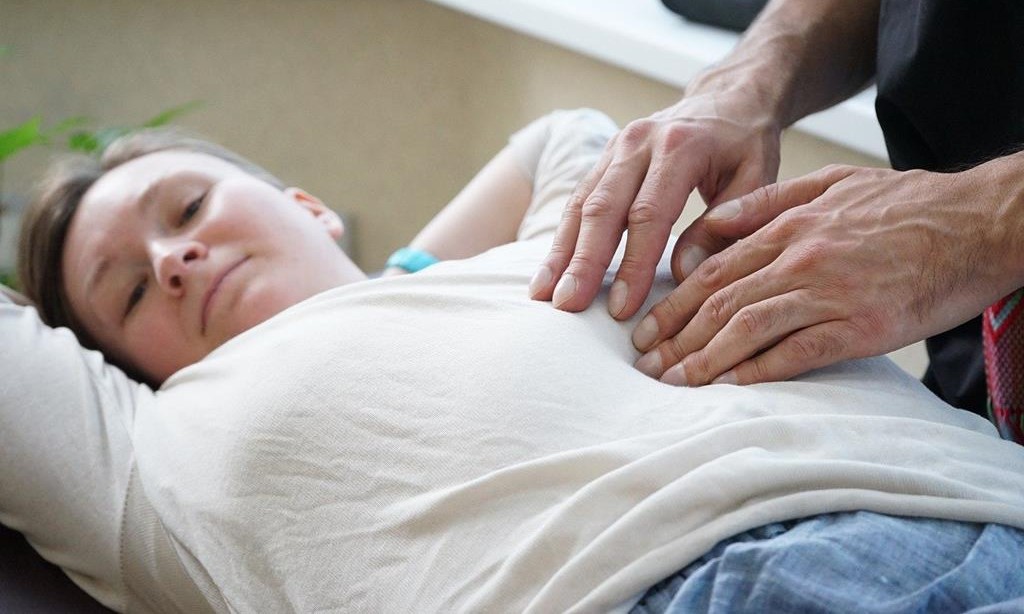Draping in massage is the practice of using sheets or towels to cover the client’s body, ensuring their privacy and keeping them comfortable during the session. It is an essential aspect of massage therapy, providing a safe and professional environment for the client and therapist.
In massage therapy, draping refers to the method of covering the client’s body with sheets or towels to maintain their privacy, comfort, and modesty during the session. It involves strategically placing the draping material over specific parts of the body while exposing only the area being worked on at a given time.
Draping also helps to keep the client warm and relaxed throughout the massage. It is an important practice in massage therapy to ensure a professional and respectful environment for both the client and therapist. By adhering to proper draping techniques, massage therapists can provide a safe and comfortable experience for their clients.
The Origins Of Draping
Draping in massage originated from ancient healing practices, where fabrics are strategically placed to maintain modesty and comfort during the treatment. This technique allows the therapist to access specific areas of the body while ensuring the client feels secure and relaxed.
Draping in massage is an essential aspect of the overall therapeutic experience.
Traditional Practices
Draping is an essential aspect of massage therapy, creating a comfortable and professional environment for both the client and the practitioner. The practice of draping has been used for centuries and has its origins in ancient cultures.
In ancient civilizations such as Egypt, Greece, and Rome, massage therapy was seen as a sacred healing practice. Massage practitioners would often use sheets or linens to cover the body during the massage process to ensure modesty and privacy for the client.
Similarly, in Asian cultures, draping was a common practice in massage treatments. In countries like China and India, massage therapy was considered an integral part of holistic healing. Traditional Chinese medicine, for example, emphasized the importance of maintaining the flow of energy or qi in the body. Draping was used to create a respectful and harmonious environment during massage sessions.
Evolution Of Draping In Massage Therapy
As massage therapy practices evolved over time, the draping techniques also underwent changes to meet the needs of diverse populations.
In the Western world, massage therapy became popular in the 19th century, with Swedish massage being one of the most widely practiced techniques. The use of towels or sheets for draping became customary during Swedish massage sessions.
With the rise of modern spas and wellness centers, the draping practices in massage therapy have further advanced. Today, therapists use a combination of sheets, towels, and specialized draping techniques to ensure the comfort and privacy of the client while allowing for effective massage techniques.
Some massage therapists may also incorporate additional draping tools, such as bolsters or cushions, to provide optimal support and positioning during the massage. These advancements in draping techniques have allowed for a more personalized and tailored massage experience.

Credit: study.com
Purpose Of Draping
The purpose of draping in massage is to ensure client comfort and maintain professionalism and boundaries during the massage session.
Ensuring Client Comfort
Draping plays a crucial role in ensuring the client feels comfortable throughout the massage. By using sheets or towels to cover parts of the body that are not being worked on, the client’s modesty and privacy are protected. This makes the client feel safe and secure, allowing them to fully relax and enjoy the therapeutic benefits of the massage.
Moreover, by draping the client, the therapist can also regulate the temperature during the massage. Keeping the client warm and cozy promotes relaxation and enhances the overall experience.
Maintaining Professionalism And Boundaries
Draping is an essential aspect of maintaining professionalism and boundaries in the massage industry. By creating a barrier between the therapist’s hands and the client’s body, a clear boundary is established, which fosters trust and respect between both parties. This helps to prevent any discomfort or misunderstandings that may arise.
Additionally, draping enables the therapist to adhere to professional, ethical, and legal standards. It ensures that only the areas of the body directly related to the massage are exposed or touched. This promotes a sense of safety for the client and establishes the therapist’s professionalism in providing the massage service.
Overall, draping serves multiple purposes in massage, including ensuring client comfort, maintaining professionalism, and setting clear boundaries. By implementing proper draping techniques, massage therapists can create a safe and comfortable environment for their clients while upholding the highest standards of professionalism and privacy.
Types Of Draping Techniques
Drapping is an essential aspect of massage therapy that ensures the comfort, privacy, and safety of the client. There are different types of draping techniques used in massage therapy, each serving a specific purpose. Proper draping not only ensures the client’s comfort but also maintains a professional environment.
Full-body Draping
Full-body draping technique involves covering the client’s entire body with a sheet or blanket. This technique is commonly used in modalities such as Swedish massage or deep tissue massage where the client is required to be fully unclothed. The therapist maintains the client’s privacy by uncovering only the specific body part being worked on while keeping the rest of the body draped.
Partial Draping
The partial draping technique involves covering only specific parts of the body while working on others. For instance, during a back massage, the therapist may drape the lower body while exposing the back. This technique maintains the client’s modesty while allowing access to the area being massaged.
Client Preference
Clients may have individual preferences regarding draping. Some may feel more comfortable with full-body draping, while others may prefer partial draping. It is important for massage therapists to respect and accommodate the client’s preference regarding draping, ensuring a positive and comfortable experience for them.
Choosing The Right Draping Materials
When choosing draping materials for massage sessions, it is crucial to consider the comfort and hygiene of your clients. Different types of materials offer varying levels of softness, breathability, and durability.
Cotton Sheets
Cotton sheets are a popular choice for draping during massages due to their softness and breathability. They provide a comfortable and cozy experience for clients while allowing for easy movement and proper airflow.
Blankets And Towels
Blankets and towels can also be used for draping, offering versatility in terms of warmth and coverage. They should be soft yet durable to withstand multiple uses and washings.
Disposable Drapes
Disposable drapes are convenient and hygienic options for maintaining a clean and sanitary environment during massages. They are designed for single-use to prevent cross-contamination and promote client safety.
Draping Guidelines And Best Practices
When securing the drapes during a massage, make sure they fully cover the client’s body.
To adjust for modesty, ensure the client feels comfortable and respected throughout the session.
Maintain high standards of hygiene and sanitation by using clean drapes for each client.

Credit: www.amazon.com
Adapting Draping For Different Massage Modalities
Adapting draping for different massage modalities is an essential aspect of providing a tailored and comfortable experience for massage clients. Draping, the method of using sheets or towels to cover the client’s body during a massage, can be adjusted to accommodate the techniques and requirements of various massage modalities. Adapting draping techniques to suit different types of massage helps ensure the client’s comfort and privacy while allowing the massage therapist to perform the specific techniques of each modality effectively.
Swedish Massage
In Swedish massage, the draping technique typically involves uncovering one part of the body at a time. This allows the massage therapist to work on a specific area, such as the back or legs, while keeping the rest of the body covered for warmth and modesty.
Deep Tissue Massage
For deep tissue massage, the draping method may involve using firm and secure draping to ensure that the client’s body remains fully covered while the therapist applies more intense pressure to release tension and knots in the muscles.
Hot Stone Massage
Hot stone massage may require adapting the draping to accommodate the placement of heated stones on the client’s body. The therapist may use towels or sheets to cover and protect the client’s skin while strategically placing the heated stones on specific areas for deep relaxation and muscle tension relief.
Addressing Client Concerns And Preferences
When it comes to massage therapy, it is crucial for therapists to address their clients’ concerns and preferences. By understanding and respecting the needs of each individual, therapists can create a comfortable and customized experience. This is especially important when it comes to draping, a technique used to cover and uncover specific areas of the body during a massage. Addressing client concerns and preferences helps build trust and ensures a positive and satisfying massage experience. Let’s explore some key aspects of addressing client concerns and preferences in draping.
Communication And Consent
Effective communication between the therapist and client is paramount in ensuring a successful massage session. Before the massage begins, therapists should establish a clear understanding of the client’s comfort level with draping. This includes discussing how much of the body will be covered, which areas will be exposed, and any specific concerns the client may have. Obtaining explicit consent from the client provides a foundation of trust and empowers them to voice any discomfort or changes in preference throughout the session.
Accommodating Special Needs
Every individual is unique, and some clients may have special needs that require additional considerations in draping. For example, clients with limited mobility may need assistance in positioning themselves comfortably on the massage table. In these cases, therapists should offer extra support or modifications to the draping technique to ensure the client’s safety and comfort. Understanding and accommodating special needs not only demonstrate professionalism but also enhance the overall therapeutic experience.
Respecting Cultural Differences
In a multicultural society, it is vital for massage therapists to respect and embrace the cultural differences of their clients. This includes being mindful of specific cultural practices or beliefs around body exposure and touch. Therapists should inquire respectfully about any cultural preferences the client may have regarding draping, and they should make necessary adjustments accordingly. Respecting cultural differences fosters inclusivity and creates a welcoming environment for all clients.
Conclusion
In conclusion, addressing client concerns and preferences plays a significant role in draping during a massage. Through effective communication, accommodating special needs, and respecting cultural differences, therapists can create a safe and tailored experience for each client. By prioritizing client comfort and preferences, therapists build trust and promote an environment where individuals feel heard and respected. Ultimately, addressing client concerns and preferences in draping contributes to a positive and satisfying massage therapy session.
Legal And Ethical Considerations
When providing a massage, draping refers to the use of sheets and towels to ensure client comfort and privacy. Understanding the legal and ethical considerations around draping in massage therapy is crucial to maintain professionalism and adhere to industry standards.
Proper draping techniques help create a safe and respectful environment for both the client and the therapist.
When it comes to the practice of draping in massage therapy, there are several legal and ethical considerations that massage therapists must keep in mind. These considerations help ensure the privacy, safety, and well-being of the clients, while also protecting the massage therapist from legal liabilities. Understanding the legal and ethical aspects of draping is crucial for maintaining a professional and reputable massage practice.
Hipaa Compliance
HIPAA, or the Health Insurance Portability and Accountability Act, is a federal law that aims to safeguard the privacy and security of individuals’ health information. Massage therapists must comply with HIPAA regulations to protect their clients’ confidential information. While draping primarily focuses on preserving modesty during a session, it is important to remember that any information shared during the massage, such as medical history or personal details, must be kept confidential. Massage therapists should implement secure record-keeping systems and maintain strict confidentiality protocols to ensure HIPAA compliance.
Informed Consent
Prior to starting a massage session, seeking informed consent from the client is essential. Informed consent involves clearly explaining the treatment process, including the use of draping, to the client. It is crucial to discuss the purpose of draping, the areas of the body that will be uncovered, and any alternative options available. By obtaining informed consent, massage therapists establish trust with their clients and ensure that they feel comfortable throughout the session. This open communication helps uphold ethical standards in the massage industry.
Professional Liability
Massage therapists must protect themselves from professional liability by adhering to legal and ethical guidelines related to draping. Any misconduct or inappropriate behavior during a massage session can lead to legal repercussions and damage the therapist’s professional reputation. Proper draping techniques and protocols can assist in preventing situations of misconduct. By maintaining professional boundaries, respecting clients’ autonomy, and consistently using appropriate draping, massage therapists mitigate the risks associated with professional liability.
Frequently Asked Questions Of What Is Draping In Massage
What Are The Benefits Of Draping In Massage?
Draping in massage ensures client comfort, privacy, and modesty. It allows the therapist to focus on specific areas while maintaining professionalism. Proper draping enhances relaxation and trust during the massage session.
How Does Draping Enhance The Massage Experience?
Draping prevents exposure, providing a sense of security for the client. It allows the therapist to manipulate muscles effectively without distractions. Effective draping promotes relaxation and helps the client feel at ease throughout the massage.
Is Draping Required In Every Massage Session?
Yes, draping is a standard practice in professional massage therapy. It is essential for maintaining ethical boundaries and ensuring client comfort and confidentiality. Proper draping techniques are crucial in upholding the integrity of the massage profession.
Can Clients Request Specific Draping During A Massage?
Clients can always communicate their preferences regarding draping before the massage session. Therapists will accommodate reasonable requests to ensure the client’s comfort and satisfaction. Open communication regarding draping expectations fosters a positive experience for both parties.
Conclusion
Draping in massage is a crucial aspect of the client’s comfort and privacy. Understanding the significance of proper draping techniques ensures a professional and ethical massage experience. By maintaining a balance between client comfort and modesty, draping contributes to a safe and respectful massage environment.
Mastering this skill is essential for any massage therapist.



